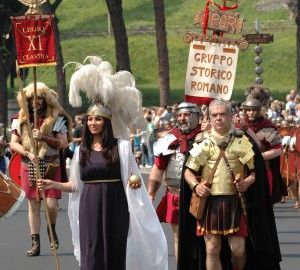Ancient Rome evoked by 50 historical groups from 10 countries
The capital celebrates its 2,768th birthday on Tuesday 21 April, with events beginning on Sunday 19 April. Known as Natale di Roma, the annual birthday celebration is based on the legendary foundation of Rome by Romulus in 753 BC.
A novelty this year will be the switching on of a new lighting system at the Roman Fora of Nerva, Augustus and Trajan at 20.30 on 21 April, while the traditional birthday celebrations take place two days earlier. The pageant on 19 April will feature 50 cultural associations from 10 different countries, including this year Russia and Georgia.
The associations will be organised by the Gruppo Storico Romano, an historical dramatic society which, for more than 20 years, has brought history to life by re-enacting battles, historic events, and displays of ancient theatre and dance in the city centre.

This year the group opens the birthday celebrations with a fire-lighting ceremony at the Circus Maximus at 10.00, followed at 11.00 with a costumed parade, which last year attracted about 300,000 people.
The spectacle involves more than 2,000 gladiators, senators, vestal virgins and priestesses and the route begins at the Circus Maximus before ending at the Colosseum at midday. There will be more historical re-enactments in the Circus Maximus from 15.00-18.00, while Monday 20 April will be devoted to educational events for schools.
On the big day itself, 21 April, the foundation of Rome is marked at the Circus Maximus in the afternoon with a number of ceremonies. Among these is the trench-digging ritual, known as the tracciato del solco, at around 16.00. This tradition recalls the founding of ancient Roman towns when a trench or mundus was dug and offerings thrown into it to encourage the gods to watch over the town's inhabitants.
This is followed at 17.00 by a re-enactment of the agricultural Palilia ceremony. Dating back to before the founding of Rome, the ceremony was held in honour of the goddess Pales, protector of flocks and herds, and involved vestal virgins distributing straw and the ashes and blood of sacrificed animals before jumping over a bonfire three times.
In recent days the mayor of Rome Ignazio Marino has promised "a surprise" for this year's edition of Natale di Roma. In February work began to restore the five missing columns of the Temple of Peace in the Roman Forum. At the time Rome's superintendent of cultural heritage Claudio Presicce said that the plan was to finish the project in time for the annual commemoration on 21 April.
The city’s birthday has been marked annually since 1870. The “date of birth” is believed to have been established by the first-century BC historian Marcus Terentius Varro who based his findings on a date ascertained by his friend, the astrologer, mathematician and philosopher Lucius Taruntius Firmanus.
For details of Natale di Roma events see the Gruppo Storico Romano website


















